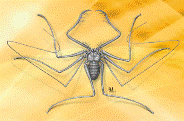Papers in the Biological Sciences

Eileen Hebets Publications
Document Type
Article
Date of this Version
1-1-2006
Citation
Journal of Arachnology (2006) 34: 545–556
Abstract
Jumping spiders have long been used as model organisms to study visual communication. However, recent studies documenting the presence of intricate multicomponent seismic songs during courtship displays suggest an important role of seismic communication as well. Given the relatively recent focus on seismic communication, the extent to which seismic songs vary among jumping spider species or even among populations remains poorly understood. Here, we use the extensively studied Habronattus pugillis Griswold 1987 complex to explore putative seismic song diversity among males from isolated populations. H. pugillis populations have been studied extensively because of the tremendous diversification of male visual secondary sexual ornaments observed among adjacent mountain-top populations in southeastern Arizona (“sky islands”). Here, we aim to explore putative parallel patterns of diversification in seismic courtship songs between different sky island populations. Using laser vibrometry, we examined in detail the songs of three mountaintop populations (Atascosa (AT), Santa Rita (SR), and Santa Catalina (SC)) and observed an extraordinary diversity of songs and song types among these three populations. Large differences were seen in both the temporal and spectral properties of male seismic songs. In addition, we observed differences in song complexity between populations with some populations having “simple” songs (1 component) and others having “complex” songs (3 components). We also present preliminary data from four additional populations (Galiuro (GA), Huachuca (HU), Mule (MU), and Patagonia (PA)). Results from this study suggest that the diversification of male visual signals observed among populations of H. pugillis finds a counterpart in male seismic songs.


Comments
Copyright © 2006, American Arachnological Society. Used by permission